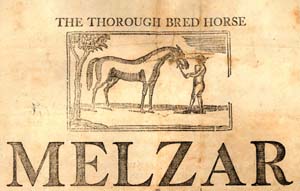

In a society where horses were the main means of transport, the fascination with the pedigree and performance of the horse was as obsessive as ours with the automobile today. Though American society was supposedly egalitarian, the stable, the racecourse, and the horse fair were among the few places where men of different classes andraces mingled. In these stud posters and in advertisements of all kinds, ordinarypeople in early America created a vernacular language that was both stylized and individual, a way of writing that eloquently expressed the mundane realities of their lives. This writing is worth studying. Of all the stud posters printed in 18th-century America, only 27 survive. All of them are known in only one copy. The Zinman collection contains 18 stud posters, two-thirds of all known examples.
Charles Gough. The Stallion Young Juniper will cover mares this season, at Charles Gough’s Lot, no.12, at Fort Augusta. Der hengst Junge Juniper… [Lancaster, 1774?]. Given by Dr. Gary Milan, at the behest of Michael Zinman.
The only known copy of the second oldest recorded stud poster. Young Juniper somehow got to Fort Augusta, now Sunbury, then at the edge of the settled area of Pennsylvania. There were no printers there, so owner Charles Gough must have traveled all the way to Lancaster to get this poster printed in German and English.
William Winthrop. English Stallions. For Sale … imported from London. New York: G. F. Hopkins, 1798.
Freeman Kilbourn. Debarsh, will cover this season, at the stable of the subscriber in Hartford. Hartford: E. Babcock, [1798?].
The Full-blooded elegant horse Young Herod…. His sire was the noted horse King Herod. [Hartford, 1800?].
Enos Farrand. Independance, (from Long-Island,) will cover this season, at the stable of the subscriber in Wardsesson. Newark: J. Woods, 1796.
Aaron Stockholm. To cover, the late imported, full blooded, fast running horse Express, at the stable of Aaron Stockholm, in Hopewell, town of Fishkill … the ensuing season. [New York, 1796?].
Federal-era horsemen evidently believed that the noblest lineages in the equine aristocracy had their roots in England. As a part of the general westward progress of civilization, American wealth was able to buy the offspring of these bluebloods to mate with Republican mares to “improve the breed” and the new nation at the same time. American breeders often gave their horses names that recalled their descent from famous English horses, Young Herod, for example. Enos Farrand gave his stallion Independance a thoroughly American name, while still touting his English lineage.
Abraham Skinner. The full blooded horse Comet, will stand to cover this season, at the stable of the subscriber in East-Hartford. [Hartford, 1795?].
Ephraim Tucker. Will cover the ensuing season, at the stable of the subscriber, living at North-Bolton … the elegant full-blooded horse Clericus. [Hartford, 1795?].
John Gilbert. The Full-blooded stud horse High-Flier and the Baronet, will be let to mares the ensuing season, at my stable at Hebron. Hartford: E. Babcock, 1797.
Charles Butler. That noted high bred horse Drone, Imported into America in the fall of ’97, will stand the ensuing season. [Litchfield, 1800?].
I. Johnston. Two capital horses … The swift running horse Feather, will stand the ensuing season ... The Virginia bred full-blooded race horse Alfred, will likewise commence covering, the ensuing season.
Litchfeld: T. Collier, 1797.
Central Connecticut seems to have been the horse capital of Federal America, judging from the high proportion of stud posters that emanated from there. Note the stock cut of horse and groom.
David Sexton. All-Fours, a first rate English studhorse--- imported to America by Abraham Skinner & Co. will stand at the stable of the subscriber in Deerfield [Mass.]. Hartford: Hudson & Goodwin, 1799.
George Wyllys. All-Fours & President, two elegant stud horses, will stand for covering mares the ensuing season, at the stable of Capt. Carshore in Claverack. [Hartford: Hudson & Goodwin, 1800].
Abraham Skinner, et al. Creeper, a first-rate, full-blooded English race Horse, imported by the subscribers, the last spring from England, will stand at the stable of Julius Deming … in Litchfield. [Litchfield, 1797?].
James Lawton. Creeper, a first rate full blooded English race horse … purchased in England by Capt. Abraham Skinner … will stand at the stable of the subscriber … in Hardwick [Mass.]. Hartford: E. Babcock, 1799.
These two horses, All-Fours and Creeper, were imported from England by Abraham Skinner of East Hartford. Each was quickly sold and resold to men who attempted to recoup their investment by offering the horses at stud. All-Fours’ owners both used the same poster format and woodcut to advertise him, and his fee rose quickly. At the same time, Creeper’s fee was falling, belying the second owner’s claim that Capt. Skinner’s “judgment in horses is well known to be as good as any man’s in America.”
Lodowick S. Babcock. Fearnaught will cover, at the stable of the subscriber…. Fearnaught was imported and kept in Virginia five years… Albany: C. R. & G. Webster, 1796.
John Hoskins. The thorough bred horse Melzar will stand at my stable, in King & Queen county… Richmond: A. Davis, 1796. see image below
Matthias Warner. To cover. Young Emperor, the full blooded hunter. New York: J. Harrison, 1796.
In addition to Connecticut, the other great horse-breeding state of the new republic was Virginia. Judging from the language of these posters, a horse from that state had its own native pedigree, though the British roots of the horses are still worth mentioning. Each of these posters has manuscript annotations that supplement the printed advertising. Mr. Babcock left blank the location of the stable of one horse and has added the up-to-date information by hand. Young Emperor, we learn, “has covered 137 mares.” And Mr. Hoskins will now ensure a foal for a slightly higher fee. His Melzar is an ancestor of Philadelphia’s champion horse Smarty Jones, eighteen generations back.

